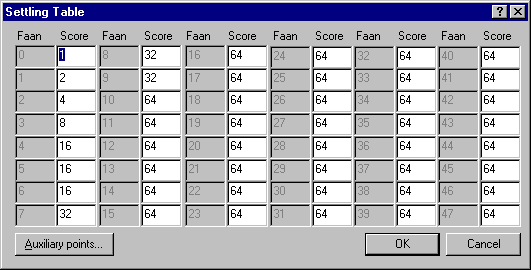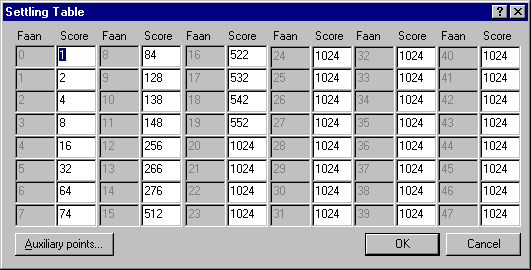In the Faan-Laak scoring system, normally used in modern Chinese versions of Mah Jong (in the Hong Kong Mah Jong and Chinese New Style rule preset), the scoring for patterns and other properties of the hand is specified by assigning a certain amount of faan units (originally "multipliers"), to each scoring item.
The final score is determined by a settling table where doubling of the final score is decelerated after the limit points (laak) specified by the rules have been achieved first time. E.g., in the table 1 below, the first laak (the base of Limit points), appears at the stage where scores have been doubled 4 times, from 1 to 2, 2 to 4, 4 to 8 and 8 to 16, after which the final score stays the same until the hand is worth 7 faan. Often the intermediate stages between two laaks specify the scoring of the lower laak, but e.g. in the Chinese New style rule presets the intermediate faans have each a different scoring value.
Notice that the final score determined by the settling table is not necessarily the same as the amount of final payment points. E.g., each loser normally pays double if the winner goes out self-drawn, and if the winner goes out on a discarded tile, the discarding player usually pays double while other losers pay normally.
No rounding is normally used in the Faan-Laak scoring system.
Note: In certain rules a complementary scoring system with auxiliary points is used for rewarding certain basic scoring patterns with bonus points. These points are converted to faans using a conversion table. If this table specifies half faans (e.g. 1.5 faans), the label headers of the settling table automatically change to display faans in increments of half point. For more information, see Auxiliary points.

1) Settling table used in the Hong Kong rule preset with limit
points set to 16 points. The first laak (Limit points) is paid for hands worth 4 to 6
faans, second Laak (limit doubled once) for hands worth 7 to 9 faans, third laak (limit
doubled twice) for hands worth 10 faans or more. The table is called "4-7-10
System" (the figures indicate the number of faans where doubling of limits occurs.)
Several other variations exist.

2) Settling table used in the Chinese New Style rule preset with
limit points set to 64 points. The first laak (Limit points) is paid for hands worth 6
faans, the second Laak (limit doubled once) for hands worth 9 faans, the third laak
(limit doubled twice) for hands worth 12 faans, the fourth laak (limit doubled three
times) for hands worth 15 faans and the fifth laak (limit doubled four times) for
hands worth 20 faans or more. Notice that individual final scores are specified at
increments of 10 points for intermediate faans. The table is called "6-9-12
System". Another popular variation in the New Style is the "5-8-11 System".
Variations related to settling tables:
Overview
Auxiliary points
Mangan scoring
Regulated doubles
Related topics:
Creating and managing custom rule presets
Initial and Limit points
Logic of scoring system
Inclusion and scoring of hands and patterns
Rounding
Penalties